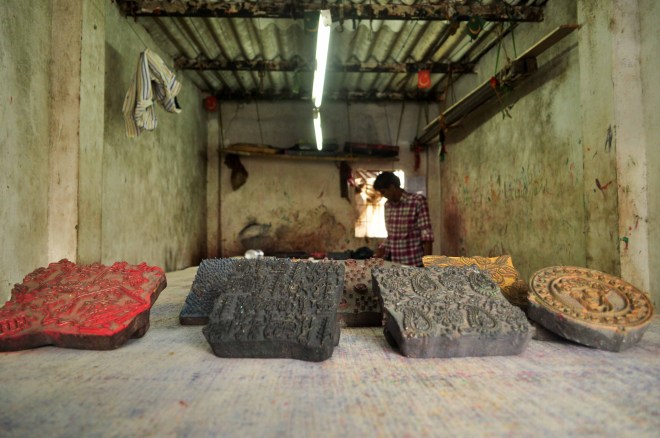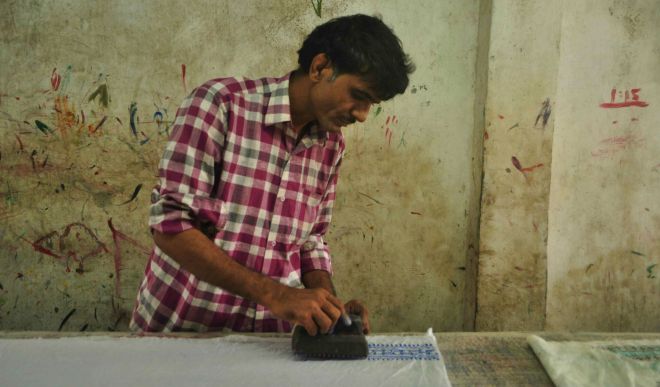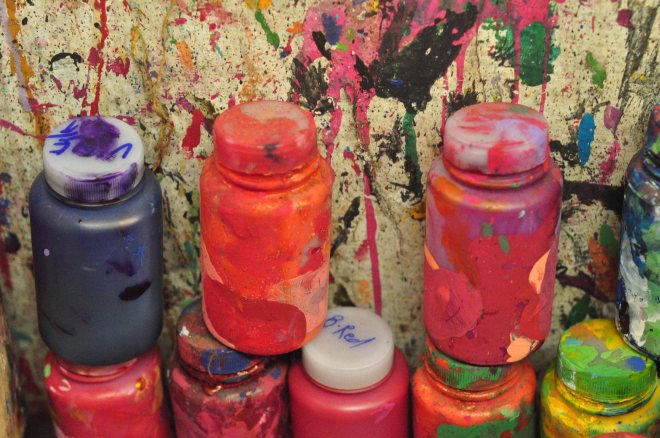The walls of Ahmed Razak Shaikh’s workshop are streaked with colours, his children’s rendering of Urdu letters and mini statements on his weekly orders. The 49-year-old blockprinter deciphers his most recent order, barely legible and written with a temperamental red pen. “On the 15th, I did 80 metres of cloth. On the 16th, I did a rye dana (seed) blockprint on 120 metres. Yesterday I did 90 metres of dupattas. It has been a good week,” he notes. We are on the second and uppermost floor of an assemblage of rooms in AKG Nagar, Dharavi, that seem put together by a child (it would be hard to call it a house or a building). It is a clammy afternoon, but there are no fans in his workshop. It is a room dependent on the elements – daylight from a couple of windows and hints of a breeze.
“Colours dry fast and fabric flutters under fans,” says Ahmed. He doesn’t use jargon, but his technical knowledge is obvious when he explains the different chemicals he uses for blockprinting. For a man who grew up in a family of blockprinters from Mirzapur in Uttar Pradesh, blockprinting is as easy and inevitable as a surname. It is more than just a source of money. “I saw blockprinting everyday at home. Back in my village, they had a stone table lined with sackcloth on which bedsheets were printed. It was part of my daily life,” he says. Living from week to week, he stays put when there are no orders rather than take up some other job for daily wages. He was destined to do this and nothing else, it seems. “This is all I know and orders have kept coming over the years. I have never felt like I wanted or needed to do something else.”
Having worked in various parts of Mumbai and in others’ workshops as a teenager assisting his father with blockprinting, Ahmed has had about 17 years of experience as a professional. He is now finally glad to have a workshop of his own. A number of blocks are heaped together under the line of tables. To the untrained eye it looks like a mess, but Ahmed knows his florals from his abstract designs.
There are rejects among the blocks – styles that have fallen out of fashion, broken corners, brass embossed. Ahmed discards them and there is no particular attachment to the blocks that have served him faithfully over the years. These days, a Nepalese artist purchases the rejected blocks from him. “They arrange these blocks into some pattern back at hotels in Kathmandu. I really wonder what they achieve by doing that. But I don’t ask questions,” he shrugs. Is he an artist? “No, I am an artisan. Blockprinting is an art, of course, but it is like this: I am happy when I get 20 pieces to block print but I am happier when I get 200 pieces to print in a day,” he says with no hint of doubt in his voice.
The room, otherwise spacious, is primarily for the long worktables and it is not easy to navigate from one side to the other. Ahmed’s three-year-old granddaughter has figured it out, though; she monkeys around and swiftly disappears under the tables. Occasionally, we see her little head popping up in different parts of the room. “I have six sons and one daughter. This is my eldest son’s daughter,” he says. The youngest son, Altaf, is asked to take the intrepid child back home (home is a floor below). Altaf, an eighth standard student and as tall as his father, was attending school until some months ago. He shows surgical scars on his left hand and leg. There is some confusion as father and son discuss the problem. “One doctor told us he has a brain tumour. Another told us he has tuberculosis. Another surgically removed his abscesses,” Ahmed says. "Cold abscess," Altaf chimes in. There is no anguish on their faces; it is just dealing with the everyday. Ahmed is more hopeful now since they have visited a baba at the outer edge of Mumbai. “Altaf has been advised to have shellfish… you know, the kind that the Kolis sell. Baba has promised that Altaf will be cured by doing this.”
Despite destiny, confidence and resilience, Ahmed does admit that the blockprinting business has been affected in recent years. Screenprinters can print around 1000 metres of cloth in a day, compared with the 100 metres he accomplishes singlehandedly. “It was also a cheaper life back then. I would buy around 10 kg of rice for the whole family on a Sunday for just Rs. 2. Everything is changing now,” he says. Ahmed’s children are not keen on taking up the trade and he is not keen on teaching others. As one of the few blockprinters left in Dharavi, a family legacy will last as long as Ahmed can print.



